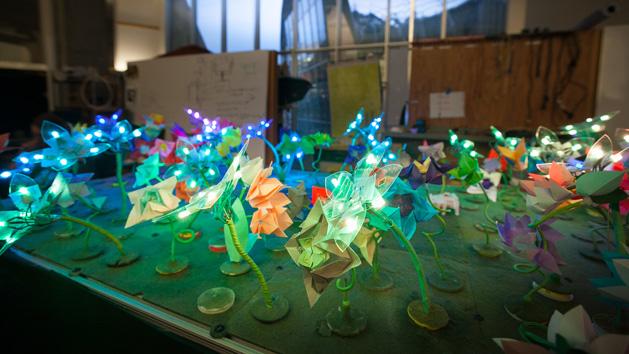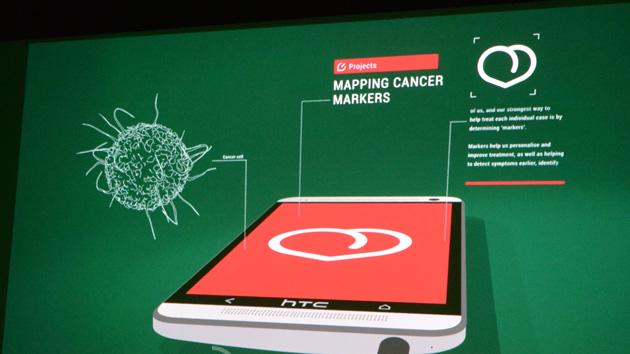distributedcomputing
Latest

DoD shows off its first successful micro-drone swarm launch
The US military is no stranger to drone development. Over the past few years we've seen everything from unhackable robot helicopters to harbor-defending pontoon platoons -- including the the means to combat them -- come out of DoD research efforts. On Tuesday, the DoD showed off its latest advancement in drone technology when it released video of the first successful aerial deployment of the Perdix swarm drone.

MIT's light-up robot garden teaches you how to code
If you're teaching kids how to code, what do you do to show that software makes an impact in the real world? MIT has a clever idea: a robot garden. The project lets you control a grid of Arduino-linked "plants" through programming that makes them blossom and light up in pretty (and occasionally mesmerizing) ways. It'll even teach the virtues of distributed computing -- you can tell these leafy robots to bloom or change color in algorithm-driven sequences. The garden is just a demo for now, but it'll eventually turn into an easy-to-replicate curriculum for students who'd otherwise have to settle for seeing their results on-screen. [Image credit: Jason Dorfman, CSAIL]

HTC wants to combine all your Android phones to cure diseases (video)
With smartphones packing so much processing power these days, HTC reckons we can combine them all to do some meaningful number crunching à la SETI@home and Folding@home. We're talking about curing diseases (AIDS, cancer, Alzheimer's and more) as well as searching for alien life. As such, the mobile company has teamed up with UC Berkeley's Dr. David Anderson, co-creator of SETI@home, for the HTC "Power To Give" initiative. To take part, you simply grab the app from Google Play, install it and it'll run in the background when your phone's being charged up plus connected to WiFi. HTC claims that the combined power of 1 million Ones is almost just as good as a one-petaflop supercomputer, so the more the merrier -- including those from other brands. But for now, HTC will first offer its app's beta release to the HTC One family and the Butterfly series, and it'll gradually add more compatible Android devices over the next six months. Isn't it awesome that even Nokia phones can soon partake in this, too? Update: The good folks at HTC have now published a couple of videos explaining this initiative. Check them out after the break.

Donate your Android device's processing power to science with BOINC
If you've ever wanted to help out with a scientific research project but lack the PhD credentials, there's now a much simpler way: all you need is a decent Android device and a new app called BOINC. Similar to projects such as Folding@Home for laptops and desktops, the app harnesses your mobile device's extra CPU cycles to help crunch data for scientific studies. Don't worry, it'll only work if you're on Wi-Fi, so it won't eat up your data plan. You can choose which research endeavor to support from within BOINC, including Einstein@Home and FightAIDS@Home that seek to discover pulsars (stellar remnants) and AIDS treatment, respectively. The app, which you can install from Google Play, was designed to be as unobtrusive as possible and will work as long as you're running Android 2.3 or higher. Generous (and envious) iOS users, sit tight -- the developer is mulling over the possibility of creating an iOS app next.

BitTorrent Torque alpha puts file seeds on the web, makes desktop apps look stale
Almost without fail, BitTorrent downloads have had to spread through a dedicated client, whether it's on the desktop or a router. Thankfully, BitTorrent Torque has just come in alpha form to liberate the peer download service from its software chains. All that's needed now is a web browser that can parse a JavaScript app. Going the new route gives some freedom to enable sharing that hasn't always been practical: among the tricks in the company's Torque Labs are drag-and-drop sharing, conversion of torrents into traditional downloads and easing the burden on a server for video streaming. The alpha stage leaves Torque with awhile to go before it's ready for the limelight, but experimenters can hit the source link to start tinkering with distributed file sharing today.

Earthquake detection software gains foothold in California
Stanford's Quake-Catcher Network has been up and running since early 2008, but it looks like it's just now starting to reach the critical mass of users that's essential for its success. As you may be aware, the software takes advantage of the accelerometers built into many new laptops to watch for any signs of shaking or vibration, which it then compares with data from other laptops in the same area -- if they're all shaking at the same time, that's a pretty good indication there's an earthquake happening. Until recently, however, there hasn't been enough users in any particular area to produce reliable data, but Stanford now counts more than 450 users in California alone, which has provided it with its first truly viable testbed. Of course, more users would be even better, and you can sign up and download the software at the link below if you're interested in helping out.

Folding@Home recognized by Guinness World Records
Finally getting the street cred that its creators have so long desired, the multi-platform, distributed computing network known as Folding@Home is to be recognized by Guinness World Records. According to the group, the network is now the most powerful distributed computing cluster in the world. The system, which utilizes the power of more than 670,000 PS3s, PCs, and lawnmower motors to crunch data, has overall computational capabilities greater than a petaflop (which is a ton of flops). The linked consoles tackle a number of tasks, and scientists harnessing the network's power are able to study complex medical problems -- such as Parkinson's and Alzheimer's -- much more quickly. Vijay Pande, Associate Professor of Chemistry at Stanford University and head of the Folding@home project says, "Without them [the Folding@Home users] we would not be able to make the advancements we have made in our studies of several different diseases." Now that Guinness has recognized the system, it can proudly stand next to luminaries such as the man with the longest fingernails, and fastest land animal.

PS3 Fanboy Folding@home team breaks the top 300!
It's been a bit since we did one of our big Sunday night Folding@Home events, but it's clear that you guys haven't been slacking off when it comes to Folding. One of our users sent us an e-mail recently pointing out that PS3 Fanboy has broken into the top 300 teams on the Folding@Home website. We are currently number 277 out of 66360 teams, well above Joystiq (#743) but trailing Engadget (#28!). I'm number 32 on our team, where are you on the list? If you haven't joined our team yet, our team number is 57793. Join up and help us (maybe) save the world![Thanks mccomber!]

AppleTV hacked to run Xgrid
It's no secret that the Apple TV is just a stripped-down Intel Mac running a lightly-tweaked version of OS X, so simply getting an app to run on the system isn't really a big deal -- we've seen full installs of OS X running on the device at this point. On the other hand, if you're just using the Apple TV as a media extender, that processor is just sitting there wasting spare cycles when you're not using the device, so this little hack to run Apple's Xgrid distributed-computing client on an Apple TV seems pretty slick. The hack is pretty simple if you've already poked around inside your AppleTV -- it mostly involves copying over the Xgrid Agent and configuring a few preference files. After that, your Apple TV's spare horsepower will be available to your network's Xgrid Controller, but you won't have disturbed the functionality of the device at all. Just the thing to speed up those VisualHub video transcoding sessions, eh? Now, if only someone would wedge the Folding@home client into this thing (hint, hint).

Your Sunday night Folding@home Foldathon reminder
Last week's announcement that the PlayStation 3 has nearly doubled the computing power of Stanford University's Folding@home project reminded us: We're delinquent in reminding you to turn on your PS3s at 8pm every Sunday night to participate in the Foldathon. If you're going to be joining us for a night of Folding, be sure to join Team Joystiq. Here's how: Nab the F@h client from the PS Store if you haven't already Launch the F@h client located under 'Network' Hit the triangle button Select "identity" Join existing team #57516 FOLD! Our friends at PS3 Fanboy are quick to brag point out that they're ahead of us by nearly a factor of five, so let's tackle them first ... then we'll deal with Team Engadget. 57516 FTW!%Gallery-2118%





